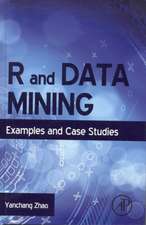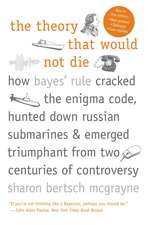Noise-Induced Phenomena in Slow-Fast Dynamical Systems: A Sample-Paths Approach: Probability and Its Applications
Autor Nils Berglund, Barbara Gentzen Limba Engleză Hardback – 19 dec 2005
In addition to the detailed presentation of the set-up and mathematical results, applications to problems in physics, biology, and climatology are discussed.
| Toate formatele și edițiile | Preț | Express |
|---|---|---|
| Paperback (1) | 691.08 lei 6-8 săpt. | |
| SPRINGER LONDON – 21 oct 2010 | 691.08 lei 6-8 săpt. | |
| Hardback (1) | 700.42 lei 6-8 săpt. | |
| SPRINGER LONDON – 19 dec 2005 | 700.42 lei 6-8 săpt. |
Din seria Probability and Its Applications
-
 Preț: 392.60 lei
Preț: 392.60 lei -
 Preț: 395.09 lei
Preț: 395.09 lei - 18%
 Preț: 739.00 lei
Preț: 739.00 lei - 18%
 Preț: 783.35 lei
Preț: 783.35 lei - 15%
 Preț: 640.24 lei
Preț: 640.24 lei - 18%
 Preț: 948.47 lei
Preț: 948.47 lei -
 Preț: 391.99 lei
Preț: 391.99 lei - 18%
 Preț: 1399.43 lei
Preț: 1399.43 lei - 15%
 Preț: 471.21 lei
Preț: 471.21 lei - 20%
 Preț: 569.10 lei
Preț: 569.10 lei - 15%
 Preț: 691.08 lei
Preț: 691.08 lei -
 Preț: 385.08 lei
Preț: 385.08 lei - 18%
 Preț: 1123.19 lei
Preț: 1123.19 lei -
 Preț: 393.52 lei
Preț: 393.52 lei - 15%
 Preț: 646.62 lei
Preț: 646.62 lei -
 Preț: 461.65 lei
Preț: 461.65 lei - 18%
 Preț: 787.91 lei
Preț: 787.91 lei - 15%
 Preț: 702.41 lei
Preț: 702.41 lei - 15%
 Preț: 557.27 lei
Preț: 557.27 lei -
 Preț: 382.36 lei
Preț: 382.36 lei - 18%
 Preț: 1120.99 lei
Preț: 1120.99 lei - 18%
 Preț: 786.49 lei
Preț: 786.49 lei - 15%
 Preț: 655.78 lei
Preț: 655.78 lei - 18%
 Preț: 785.68 lei
Preț: 785.68 lei -
 Preț: 385.25 lei
Preț: 385.25 lei - 15%
 Preț: 701.90 lei
Preț: 701.90 lei - 18%
 Preț: 915.79 lei
Preț: 915.79 lei - 18%
 Preț: 1345.87 lei
Preț: 1345.87 lei - 18%
 Preț: 733.65 lei
Preț: 733.65 lei -
 Preț: 384.31 lei
Preț: 384.31 lei - 15%
 Preț: 582.80 lei
Preț: 582.80 lei -
 Preț: 361.42 lei
Preț: 361.42 lei - 15%
 Preț: 709.09 lei
Preț: 709.09 lei - 15%
 Preț: 644.95 lei
Preț: 644.95 lei - 15%
 Preț: 648.24 lei
Preț: 648.24 lei - 18%
 Preț: 897.02 lei
Preț: 897.02 lei - 15%
 Preț: 528.13 lei
Preț: 528.13 lei - 15%
 Preț: 727.59 lei
Preț: 727.59 lei - 15%
 Preț: 470.88 lei
Preț: 470.88 lei - 18%
 Preț: 1001.81 lei
Preț: 1001.81 lei - 18%
 Preț: 954.14 lei
Preț: 954.14 lei -
 Preț: 392.60 lei
Preț: 392.60 lei - 15%
 Preț: 652.31 lei
Preț: 652.31 lei - 18%
 Preț: 1396.43 lei
Preț: 1396.43 lei - 18%
 Preț: 966.15 lei
Preț: 966.15 lei - 18%
 Preț: 1335.93 lei
Preț: 1335.93 lei
Preț: 700.42 lei
Preț vechi: 824.03 lei
-15% Nou
Puncte Express: 1051
Preț estimativ în valută:
134.07€ • 145.68$ • 112.69£
134.07€ • 145.68$ • 112.69£
Carte tipărită la comandă
Livrare economică 21 aprilie-05 mai
Preluare comenzi: 021 569.72.76
Specificații
ISBN-13: 9781846280382
ISBN-10: 1846280389
Pagini: 276
Ilustrații: XIII, 276 p. 57 illus.
Dimensiuni: 155 x 235 x 18 mm
Greutate: 0.52 kg
Ediția:2006
Editura: SPRINGER LONDON
Colecția Springer
Seria Probability and Its Applications
Locul publicării:London, United Kingdom
ISBN-10: 1846280389
Pagini: 276
Ilustrații: XIII, 276 p. 57 illus.
Dimensiuni: 155 x 235 x 18 mm
Greutate: 0.52 kg
Ediția:2006
Editura: SPRINGER LONDON
Colecția Springer
Seria Probability and Its Applications
Locul publicării:London, United Kingdom
Public țintă
ResearchCuprins
Deterministic Slow-Fast Systems.- One-Dimensional Slowly Time-Dependent Systems.- Stochastic Resonance.- Multi-Dimensional Slow-Fast Systems.- Applications.
Recenzii
From the reviews:
"This well-written book presents an approach based on a series of articles of both authors. The main aim is a characterisation of typical sample paths for slow-fast systems. Presenting a detailed exposition of the setup and mathematical results, as well as a path to recent applied research, the book is aimed at a wide range of readers, from advanced students to researchers in mathematics, physics, or engineering." (Dirk Blömker, Mathematical Reviews, Issue 2007 b)
"This well-written book presents an approach based on a series of articles of both authors. The main aim is a characterisation of typical sample paths for slow-fast systems. Presenting a detailed exposition of the setup and mathematical results, as well as a path to recent applied research, the book is aimed at a wide range of readers, from advanced students to researchers in mathematics, physics, or engineering." (Dirk Blömker, Mathematical Reviews, Issue 2007 b)
Textul de pe ultima copertă
Stochastic differential equations play an increasingly important role in modeling the dynamics of a large variety of systems in the natural sciences, and in technological applications. This book is aimed at advanced undergraduate and graduate students, and researchers in mathematics, physics, the natural sciences, and engineering. It presents a new constructive approach to the quantitative description of solutions to systems of stochastic differential equations evolving on well-separated timescales. The method, which combines techniques from stochastic analysis and singular perturbation theory, allows the domains of concentration for typical sample paths to be determined, and provides precise estimates on the transition probabilities between these domains.
In addition to the detailed presentation of the set-up and mathematical results, applications to problems in physics, biology, and climatology are discussed. The emphasis lies on noise-induced phenomena such as stochastic resonance, hysteresis, excitability, and the reduction of bifurcation delay.
Nils Berglund joined the research group "Classical and Quantum Dynamics" at the Centre de Physique Théorique (CNRS) in Marseille-Luminy in 2001. He teaches in the Mathematics Department of the Université du Sud Toulon-Var.
Barbara Gentz joined the research group "Interacting Random Systems" at the Weierstrass Institute for Applied Analysis and Stochastics (WIAS) in Berlin in 1998. She teaches in the Institute of Mathematics at the Technical University in Berlin.
In addition to the detailed presentation of the set-up and mathematical results, applications to problems in physics, biology, and climatology are discussed. The emphasis lies on noise-induced phenomena such as stochastic resonance, hysteresis, excitability, and the reduction of bifurcation delay.
Nils Berglund joined the research group "Classical and Quantum Dynamics" at the Centre de Physique Théorique (CNRS) in Marseille-Luminy in 2001. He teaches in the Mathematics Department of the Université du Sud Toulon-Var.
Barbara Gentz joined the research group "Interacting Random Systems" at the Weierstrass Institute for Applied Analysis and Stochastics (WIAS) in Berlin in 1998. She teaches in the Institute of Mathematics at the Technical University in Berlin.
Caracteristici
The approach used here allows researchers and practitioners to quantitatively describe domains in a way that is close to reality - this is the first approach to do this Several concrete examples are described in detail to show how the method works in practice. The examples are from physics and climatology - two of the main disciplines to use these methods Includes supplementary material: sn.pub/extras












